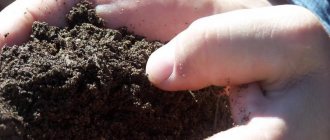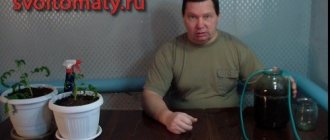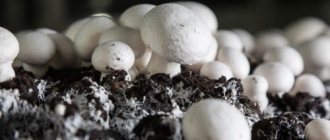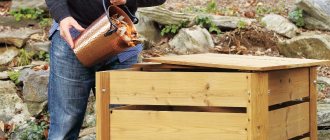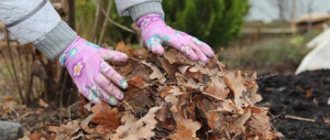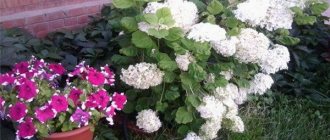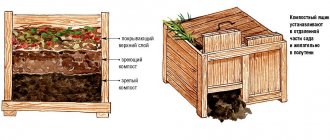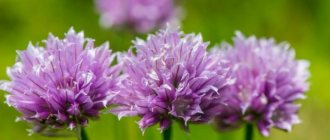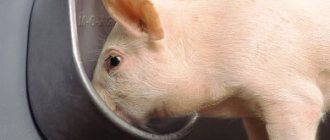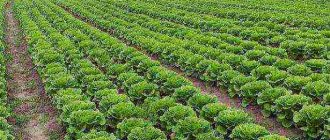What is compost and how to make it yourself
“What is compost and how to make it?” - this is a question that novice summer residents often ask. Compost is an organic fertilizer obtained by decomposing various raw materials of plant or animal origin.
You can make compost yourself at your summer cottage. There are two options for making natural fertilizers for the garden.
- Compost heap. This is the most common option for producing compost; it is also cheap and simple. You will need to make the frame in such a way that air and moisture can get inside. The best material for manufacturing would be wire mesh. Preparation of compost from the beginning of laying to full maturation takes from six months to 9 months.
Compost pile at home
- In a special box for receiving organic fertilizers. You can buy it in the Sad-Ogorod store departments. This device is protected from insects getting inside. Inside the box there is a drum that turns the substance. In addition, in the middle of the container there is a hose for moistening the waste.
COMPOST - GARDEN GOLD
This is our garden. All plants in the garden and house are grown on compost or with the addition of compost.
I decided to write about compost for two reasons:
- compost is the basis for growing beautiful and healthy plants,
- While studying the site visit statistics, I saw the search phrase “What to replace compost with?” Lately I’ve been seeing it more and more often, so it’s worth writing about.
To live, plants need: sunlight, air, water and nutrients (nitrogen, phosphorus, potassium and other microelements). Plants get their nutrition from the soil. With a lack or excess of nutrients, the plant weakens, gets sick and may die. The lack of nutrients is compensated with fertilizers. Fertilizers are organic and mineral.
Organic fertilizers - compost, rotted manure, bird droppings.
Mineral fertilizers, as a rule, contain one main component. They are divided into nitrogen, phosphorus, potassium, magnesium, boron, etc. There are complex fertilizers consisting of two to three elements. The concentration of nutrients in mineral fertilizers is much higher than in organic fertilizers. It is necessary to use mineral fertilizers with extreme caution, strictly following the recommendations; they cannot be used “by eye”.
So, compost is an organic fertilizer. It has long been noticed that if you fertilize plants with real compost, they do not get sick. It would not be amiss to remember organic farming - the basis of our health. Organic farming uses only compost.
Methods for making compost?
Experienced gardeners recommend preparing organic matter with your own hands. The options that provide the most effective results are a compost heap or compost bin. In these cases, waste decomposition and rotting occur best, because inside the layers the temperature and humidity are practically unchanged. The ripening time of organic matter directly depends on the volume of filling: the most filled pits and the largest ones become ready for use more quickly.
The most acceptable are compost heaps with the following parameters:
- width – 1.5 m;
- length – 2 m;
- depth - about a meter.
You can double the size and make two compartments: one for storing finished compost, the second for laying new one.
It is also possible to place a compost heap directly on the ground. It will also be well ventilated in natural conditions. Excessive moisture should be avoided. When putting waste into a pile, don’t get carried away; the optimal sizes for it are:
- base perimeter – 1x1 m;
- in height – 1 m 20 cm.
Compost bin
Necessary components for a normal composting process:
- oxygen;
- water;
- nitrogen.
In the presence of these factors, beneficial bacteria begin to act and participate in the decomposition process, and thus compost is prepared.
Composting is the first step to eco-farming in the country
Active and often not very correct exploitation of the land leads to its rapid impoverishment. Almost all stages of gardening - weed control, harvesting and clearing the garden of tops - cause the soil to lose nutrients. If this process is irreversible, after 2-3 seasons you will have to forget about getting quality fruits, even if you work hard. But it’s quite easy to correct the situation by making compost and applying it to the soil according to all the rules.
Under natural conditions, nature itself takes care of the production of compost. She is able to “make” it from fallen leaves, withered grass, food waste and excrement - in general, from everything that rots and decomposes into the very compounds thanks to which a new plant grows at a favorable moment. Remember a trip to the forest and a “blanket” of rotted organic matter on the ground, which does not know what human care is, and yet gives birth to bushes and trees of unprecedented height.
What are we doing at the dacha? Trying to remove the plot completely, down to the slightest speck, we don’t even think about the fact that we are depriving the land of a chance for at least some additional enrichment and thereby preventing nature from growing crops for us. So, to make compost, just 3 simple steps are enough:
- prepare a special place for rapid rotting at home;
- collect sufficient compost material naturally;
- wait until the compost has completely rotted and put it in the beds.
Now, knowing the secret of composting, you can “make” (and farmers say, grow) good black soil with your own hands, no matter how poor the soil on your site was initially.
How to start preparing compost?
Before you start composting, you need to prepare a shallow hole (the depth is approximately equal to the bayonet of a shovel). The lowest layer in the pit should be small branches cut from fruit bushes or trees. This layer acts as drainage, allowing excess liquid to flow down.
If you already have ready-made compost, then a small part of it should be placed on the branches. This will speed up the decomposition process; beneficial bacteria from the finished humus will enter new layers. For all subsequent layers, food plant waste or grass, leaves from the site are used. They are evenly distributed on the surface, trying to compact them, and watered with water. Sprinkle earth on top.
To prevent the pile from falling apart and being blown away by the wind, it is worth surrounding it with a fence made of boards or wire mesh with large cells. The top is covered with a special covering material (spunbond); in extreme cases, straw is used. So you have a finished composter with your own hands.
The use of dark film is not recommended, because air exchange will be disrupted and putrefactive processes will begin.
Making compost for the garden
How to do without a composter
Autumn is the time when you need to not only make supplies for the winter, but also think about the next season. It will be very good if you have time to arrange thermal beds by the beginning of frost, since in the spring they will save you a lot of time and effort. Here are just a few advantages of this method of organizing your site:
- there is no need to construct a container for compost and allocate space for it;
- there is no need to transport it to the beds;
- due to earlier warming up of the soil, spring work can begin a week to a week and a half earlier.
Arranging a warm bed involves laying materials for future compost directly into the soil where it is planned to plant certain crops. There are 3 main options for its construction:
- buried - the turf is removed in the right place and a track is dug, into which organic matter is subsequently laid;
- raised - when finished, it looks like a box, the fences of which are made from scraps of slate, boards, metal, or even concrete or stones;
- bed-hill - is a variation of the previous one and differs from it in the arched shape of the embankment and the absence of sides.
The choice of option depends on the conditions at your dacha: for dry areas it is recommended to make the warm bed buried, for excessively wet areas – raised. If you want to increase the usable area of the plot, it is better to arrange a bed-hill and use its entire surface for sowing.
To create a kind of warm floor in the garden, follow the important principles of laying compost in the garden bed:
- It is recommended to cover the bottom with a mesh with small cells - this way you will protect the structure from infestation by rodents;
- The first layer, up to about 45 cm thick, should be large, long-rotting debris: thick branches, small stumps, coarse stalks of corn and sunflowers, wood trimmings;
- Then you can fill the trench without compacting it with plant residues, and if they are too fresh and juicy, you need to lay them out with paper, straw or hay;
- if deciduous trees grow nearby, you can add a layer of fallen leaves 10–15 cm thick, which needs to be watered a little;
- Finally, you need to lay a fertile layer of soil and cover the bed with black film to protect it from weed seeds carried by the wind.
This design should begin to be used at the beginning of next spring. By that time, the soil will be saturated with nutrients and warm up as a result of the decomposition of raw materials. So in the first year of use, try to plant zucchini, pumpkin, cucumbers, and tomatoes, as the development conditions for them will be ideal.
What components does compost consist of?
Compost is a natural nutrient that helps restore soil structure and increase its fertility. But first you need to know how to properly prepare compost. It is necessary to create certain conditions for composting to proceed normally:
- Creating an optimal moist environment inside the compost heap. It should approach readings from 45 to 70%. But if it is not possible to measure humidity readings, then this is done “by eye” - the normal moisture of a substance resembles a wrung out sponge. The temperature indicator is also important - within 28–35 degrees. Waste that is overdried will not decompose, and waste that is too wet will begin to rot. In hot and dry weather conditions, compost needs watering. If it rains constantly, then you should definitely turn over the contents of the pit. It is unacceptable to overheat the substrate above 60 degrees, because at this temperature all beneficial bacteria die.
- A prerequisite is oxygen access to all layers of the compost heap. To do this, it needs to be shoveled constantly (about 2 times a month), with the lower layers lifted up, and the side layers moved to the center.
- The presence of bacteria and earthworms in the compost pit will have a positive effect on the process of composting biomaterials. They participate in the decomposition of waste.
Observing all the conditions, you can prepare compost at your dacha with your own hands quickly and easily.
What ingredients can you use to make compost?
We have learned how to make compost, now we need to figure out what ingredients are suitable for this. Symbolically, all components can be classified into two varieties:
Components with a high level of nitrogen are otherwise called green mass. These include:
- cultivated herbs;
- massive parts of vegetable and fruit plants;
Making compost from greens
- food waste of plant origin;
- bird droppings, domestic animal manure.
Do you use folk signs in gardening?
This content stabilizes the carbon and nitrogen balance of humus:
Components containing carbon or brown mass. This includes sawdust from trees, straw, fallen leaves, trimmed branches, crushed and soaked cardboard and paper waste. They contain a large amount of fiber, which provides food for beneficial bacteria. These components are also involved in loosening the biomaterial and saturating it with useful substances.
Before adding all the components to the compost heap, they need to be crushed. Then the processing time will be reduced. It is also important to make the correct laying, alternating a layer of green mass with a layer of brown mass. This layered arrangement will saturate the compost with oxygen and speed up its maturation.
Using compost as a fertilizer
Having understood all the features and preferences of the waste collection pit, you need to better know how to use compost as fertilizer. Compost is an indispensable natural fertilizer that provides cultivated plants with important nutritional components. It creates the necessary balance of moisture and heat in the soil. Helps the activity of microorganisms and enriches the soil.
During the autumn digging of the beds, the compost heap is dismantled and organic matter is added to the soil, and this is done without waiting for complete decomposition. Half-rotted remains are suitable for fertilizing the soil before winter; they will have time to decompose over the long winter period.
For spring fertilizing, ready-ripened compost is used. It is introduced into the ground when preparing beds for planting, and poured into furrows and holes when planting seedlings or sowing seeds. Mature compost is used to mulch seedlings, strawberry bushes and other perennial plant crops. Adding compost retains moisture in the soil and enriches plants with useful substances.
After reviewing this information, you can draw a conclusion. By growing vegetable and garden crops, you can do without serious material costs for purchasing special fertilizers and growth stimulants. To get a good harvest, it is enough to know how to properly make a compost heap, be able to prepare it and use it for planting.
What is better not to add
To understand how to make good quality compost, you need to remember the main rule - do not put unacceptable components into it:
- Under no circumstances should you add plant matter from diseased plants; infections are not killed by composting.
- Do not use large branches and other bulky pieces of trees for laying; they take a long time to decompose and slow down the maturation of humus.
- Weeds with seeds, even if the seeds are not yet ripe.
- You cannot use synthetics, plastic, glass, or glossy paper for pits.
Do not throw bottles into the compost pit
- Organic, difficult to decompose waste - bones, fat, lard.
- The use of citrus waste is unacceptable - it kills beneficial bacteria and insects.
- You cannot use potato and tomato tops, lily of the valley, castor beans - they contain toxic components that destroy some valuable microorganisms and slow down decomposition.
How to tell when compost is ready
Ripe compost has several characteristics:
- the substance inside the compost heap looks solid, there are no single components in it (leaves, stems, peelings, etc.), only thin branches can be seen;
- organic matter acquires a dark brown color, sometimes black;
- humus smells like forest soil after rain;
- In terms of thickness, the mass becomes loose and flows well.
In general, mature compost resembles black soil, sometimes it contains particles that are not completely decomposed, and it is because of them that the porosity and friability of the organic mass is obtained.
How to cause rapid ripening of humus?
Typically, as already noted, compost becomes ready in 6–9 months. But if you urgently need to speed up the process, there are some tricks:
- Herbal infusion. Take 5 shares of finely chopped herbs, combine with two shares of chicken manure and add 20 shares of water. Stir and incubate for several days.
Herbal infusion for compost
- Regular baking yeast will also speed up the preparation of humus. A tablespoon of dry yeast should be dissolved in a liter of warm water, add 200 g of granulated sugar. The liquid is ready. It moisturizes the contents of the compost heap.
- The use of special drugs (biodestructors) helps. They consist of organic matter and include many bacteria, which is why the composting process is accelerated. In store departments you can find “Baikal-Em”, “Shine” and other similar products.
Unforeseen situations during the maturation of organic matter
Sometimes when preparing humus with your own hands, small problems arise. What to do in such cases? Here are some examples:
- If there are ants in the heap, it means that it is very dry inside and decomposition has slowed down. You need to loosen the contents and water generously.
- If you notice fungus gnats above the compost, take a closer look at their numbers. If their number is small, there is no need to worry; these midges are always present in such places. But if there are quite a lot of them, then this is a sign of waterlogging in the heap. Wait until it's a hot, dry day and aerate the compost by removing the lid for a couple of days. You can also add fine clean sand from the river (dry) or sawdust.
- If the pit smells unpleasant, and the substance itself feels slimy to the touch, then this indicates the presence of a large number of components of plant origin. It is necessary to equalize the balance by adding solid components - shredded cardboard or paper, leaves, small branches, straw.
- If there is no change in the compost heap, then it has probably dried out. In this case, adding fresh grass or potato peelings will help solve the problem, and you need to moisten the entire contents.
Obtaining soil and organic fertilizer vermicompost
What is vermicompost? The red Californian worm, a relative of the simple earthworm, “tamed” by man, passing organic residues through itself, produces “on the mountain” the most valuable organic fertilizer vermicompost, which is used for feeding seedlings and indoor flowers, germinating seeds, when planting seedlings in beds in the garden, when planting potatoes, when they are added to each hole. Vermicompost soil helps accelerate the growth and development of plants. It is also useful when sowing a lawn. In this case, 1 kg of seeds are mixed with 3 kg of vermicompost, then they are scattered evenly and lightly embedded in the ground with a rake. Californian worms are also indispensable for maintaining country toilets. They literally feed on the contents of the cesspool, and the unpleasant odors that usually accompany these establishments disappear. Now there are nurseries of these useful creatures and entire farms where vermicompost is produced.
If you wish, you can organize the production of vermicompost and breed them at home; for this purpose, special technologies for breeding worms have been developed. The essence of these technologies is that two boxes with a coarse mesh bottom are placed on top of each other in a sort of stack.
Food for worms - finely ground plant and other organic residues along with worms are poured onto the lower level. As they eat the contents of the box, vermicompost is formed there. Then (or immediately, it doesn’t matter) the box located above is filled with organic residues, the worms crawl there and begin to colonize the new space. And the bottom drawer with ready-made vermicompost can be put into use. Having freed it from its contents, it is put back in place with the upper tier, and the process continues further. The difficulty is that this living “factory” for the production of vermicompost cannot be left unattended for more than two weeks, since without food the worms will simply die.
- Author: admin
Rate this article:
- 5
- 4
- 3
- 2
- 1
(4 votes, average: 3.8 out of 5)
Share with your friends!
